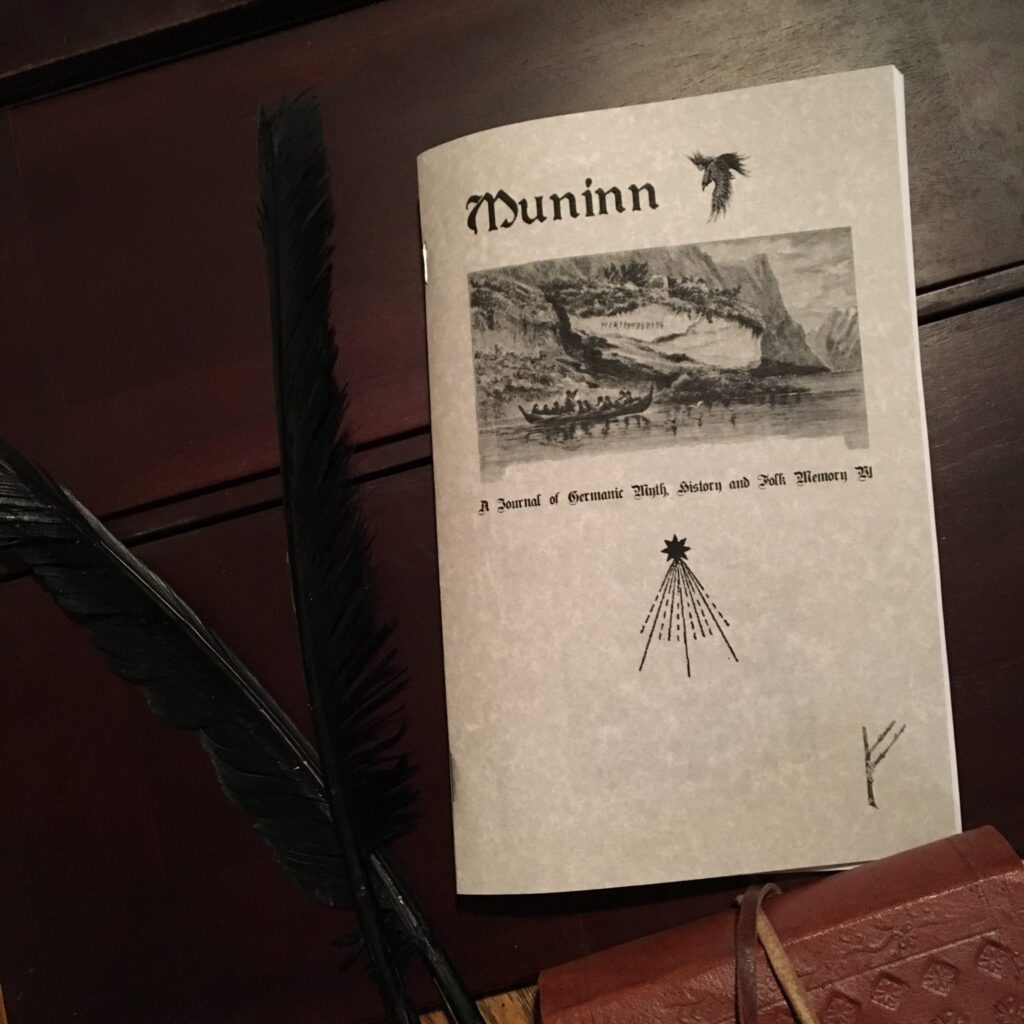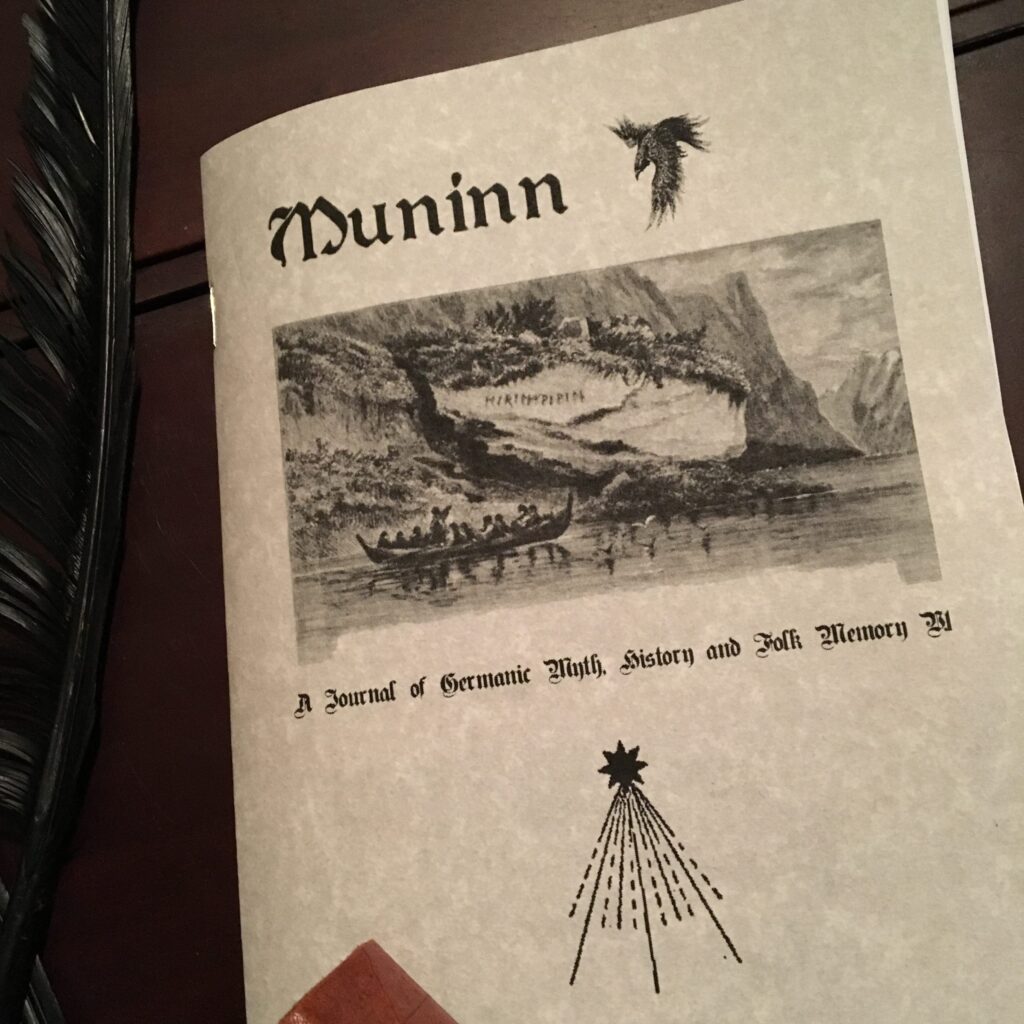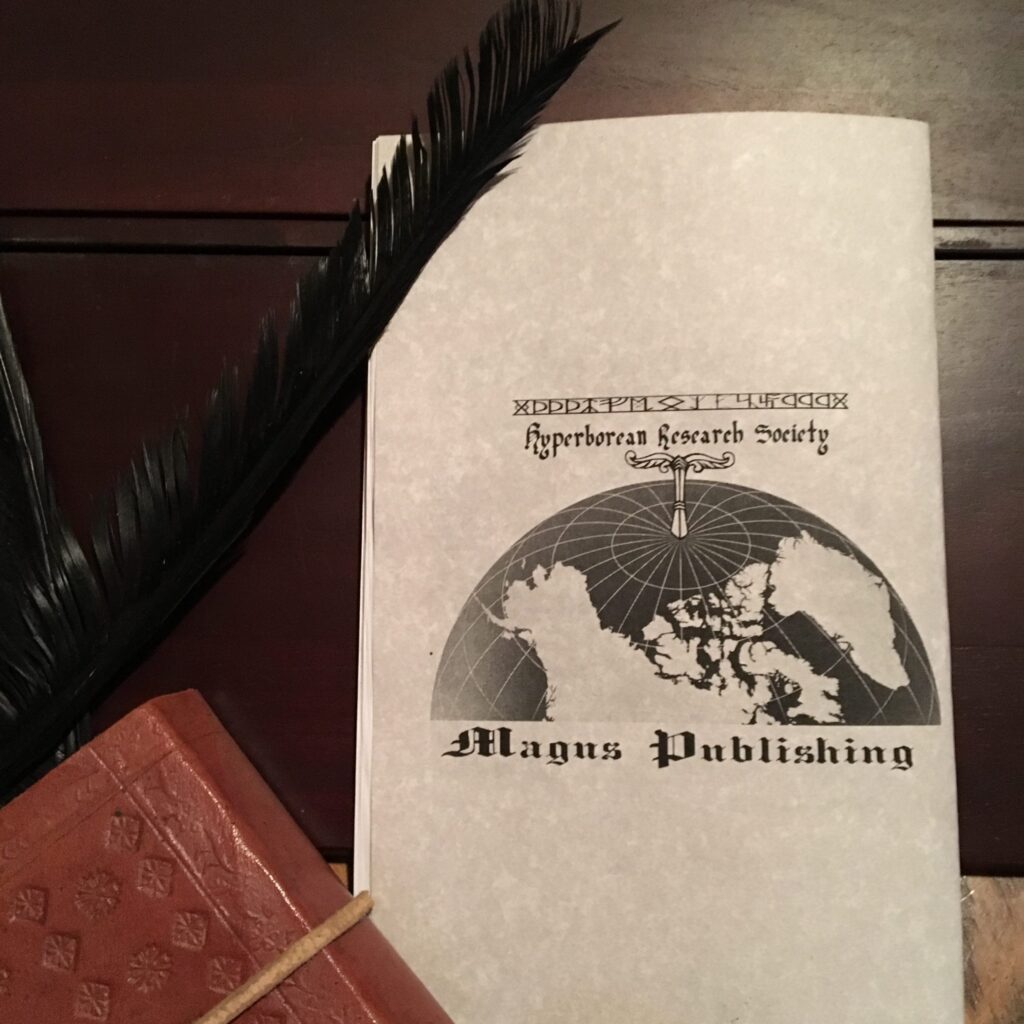Your shopping cart is empty.
Items/Products added to Cart will show here.



Muninn
Hugin and Munin
fly each day
over the spacious earth.
I fear for Hugin,
that he come not back,
yet more anxious am I for Munin.
Thought and Memory each morning fly
Over the vast earth:
Thought, I fear, may fail to return,
But I fear more for Memory.
From Proto-Indo-European *men- (“mind”). PGmc: *muniz
ON: munr -> muninn Munr~Old Norse word munr comes from Proto-Indo-European *mnā-, and later Proto-Germanic *muniz (.)From Proto-Germanic *muniz (“mind, memory, desire”). Muniz mind, memory, feeling, emotion, love, desire.
In starting this series, we wanted to find a title that conjured the atmosphere of what we sought to achieve with the publication. There are quite a few ancient terms for memory, or remembrance, or recalling within ancient Northern languages as that is the goal of this folio: to prompt true knowledge, which is always only Remembering. Though it is an endlessly debated etymology, we chose Muninn, the raven of Odin, whose role as Mind and Memory are the same cohesive sense of Self, and the ancestral Master Narrative. Our research goal is to piece together the fragments of a tradition obscured and destroyed, to sift the ruins of history for initiatic Tradition and skillful means. We present here the artistic visions of artists who invoked and saw glimpses of the past, and it is immortalized in artistic representations and stylized sacred nostalgia. There is a story told in pictures with minimal commentary, an unfolding of the cycle, of the world ages, of our struggle and history.
We are a cult of Memory, of the Great Recalling, the longing and sacred nostalgia for a past that permeates our present. All initiation is training to remember to Remember in the depths of the abyss. Tradition and Memory are identical, as they are the same word in Sanskrit, for example. Mindfulness and Memory are identical in the experience of the continuity of self, time and reality. To be Mindful is to Remember, to Learn is to Remember, to uncover, as in the term ‘alethia’ derived from the term of the waters of forgetfulness, or lethe. Our entire body of literature is piecing together the various traditions, these sacred streams from the ancient Indo-European and Hyperborean, Orphic Mysteries and related Traditions where one has the runic talismans to chose the write spring to drink from in the underworld, the stream of Mnemosyne. Just as Odin had to search for the runes for nine nights, and lay with a titaness for three for the mead, Zeus in the Greek mysteries lays with the Goddess Mnemosyne for nine nights, disguised as a shepherd and she births the nine muses. The search for Memory is a key concept within all Nordic and Germanic esoterics, from Odin’s seeking of the Völva’s Prophecy, but also her old memories of the past. Odin seeks to drink the waters of Mimir, other sagas mention the memory draughts, to Odin’s concerns for his raven’s Huginn (Old Norse: “thought” and Muninn (Old Norse “memory or mind”). Odin’s quest for the runes also link magic and Memory as all writing is an instrument of memory, the just as monuments, the poetic lore that is remembered by the bards, the rune stones are magical acts to preserve certain truths and memories. Those interested in the further discussion on these matters will enjoy our series Mnemosyne. Though we digress to these subjects in this essay, this series is entirely devoted to Germanic and Norse historical topics and Gods.
We all have an inflicted, traumatic amnesia from centuries of the Occult War. Through the lore, the ancestral herbs and mythos, we can awaken what is dormant and concealed under shadows within. We have spent substantial time and effort putting research online as part of our related guild projects. But there is something about the printed paper, handling the item away from a screen, it gives a pause of reflection. Rather than pouring so much energy into electronic content that become lost in the blur, in the social media censoring, the shadow banning, the risk of offense, we prefer to create little monographs, micro-publications, pamphlets, Commonplace books or zines. Such mediums harken back to the early occult and esoteric literature of the first printing presses, to the herbalist, astrological and farmer’s almanacs, the obscure literary and independent publications of European intelligentsia, research societies and magical groups.
This will be an ongoing series of miscellanea in celebration of Traditional Northern folklore, art, music, literature, esoterica, and whatever we feel important to highlight, present and preserve for Remembering for the readers in our guild, in our kindred and in our family. We invite you to enjoy reading, away from the screen and electronics, and we hope we inspire you to investigate the topics discussed and to begin your own research and join us or to inform us of your own efforts. We would love to see a resurgence in a true literati movement representing the Northern pagan, Hellenic and Hermetic weltanschauung. Your continued support will allow us to do more elaborate and complex projects and we have some beautiful, initiatory and alchemical art and projects to share.
This is a visual presentation with captions and commentary of history, lore, and mythos, things to Remember, to Love, To Cherish. Their heroic deeds are presenced in the visions of artists, who drew the Germanic people with wings as if they were the Gods themselves. We have attempted to highlight some of the key historical moments, to capture the atmosphere of the past, glimpses of the ancestral ways, whispers of the Gods, the Runes, the sacred groves. For many of us, there is a deep yearning, a longing, a restless wandering spirit as the echoes of the voices of the past echo within. These memories are in the blood, the bone, the sinew and nerves.
For more writings see the Etsy Shop of Magus Publishing at www.etsy.com/shop/maguspublishing
Your shopping cart is empty.
Items/Products added to Cart will show here.